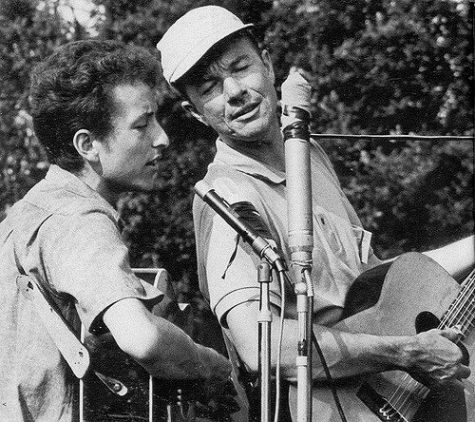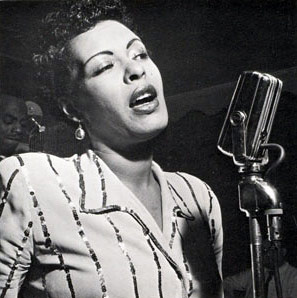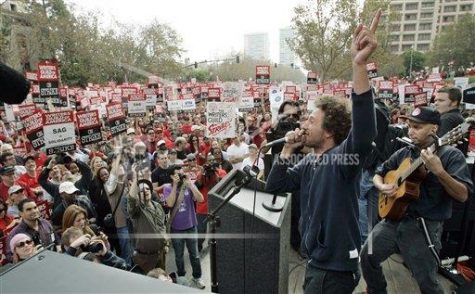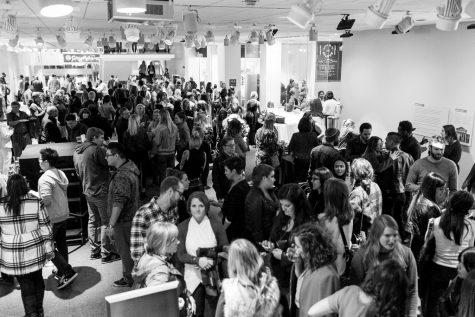The Music of Protest

Bob Dylan performs with Pete Seeger
Heads recently turned in response to Bob Dylan’s Nobel Prize in literature–never before has the prize gone to a songwriter. Even more surprising is Dylan’s apparent refusal to accept or even acknowledge the award. But perhaps this behavior matches perfectly what Dylan is arguably known best for: his protest songs.
The word “protest” may sound jarring, but its historical significance is only reinforced by the Nobel Committee’s most recent choice in recipient. To put it simply, a protest song is one that makes a statement about society, politics, or a social movement. These works have become an American tradition in the art of song, especially over the past century. Although only one artist has been recognized with a Nobel Prize, there is a whole world of protest music that holds a similar significance.
With that in mind, let’s take a look at how protest songs have evolved.

Billie Holiday had both strong vocals and a strong influence on jazz music.
1920s-30s
One of the most classic tunes in the library of social commentary is “Strange Fruit,” sung by Billie Holiday. During a time of segregation and violence toward African Americans, this song’s dark lyrics and slow tempo describe the graphic site of a lynching. Stylistically, it fits the standard sound of its day: jazz. But with lines such as, “blood on the leaves and blood at the root,” the lyrical content is what really gave this song its power. Since then, it has been covered by multiple artists, and its message remains just as relevant today.
1940s-50s
The transition into the 40s and 50s marked a shift in sound from jazz to folk, and music became more saturated with an attitude of protest than ever before. One song that many of us learned as young children just happens to be an icon of this very era.
Woody Guthrie’s recording of “This Land is Your Land” may sound like a light-hearted folk tune, but Guthrie originally recorded it with a grudge in mind. After hearing “God Bless America” one too many times, he decided to release a song that declared America as a land for everyone, no matter where they came from. In an unreleased verse, Guthrie directly criticized the border patrol and immigration system for being too harsh. This sentiment strongly defied the patriotism of the day, yet the tune’s continued prevalence in American culture is a testament to the power of such songs.
Over the next several years, the folk song would remain the most common style among protest music, but a new subject matter was quickly moving to the forefront:
The Vietnam War.
1960s-70s
During this time, which spanned nearly two decades, the music scene exploded in opposition to the war. Some criticized the draft; some sang of the destruction and devastation. Others remained hopeful for a resolution. These years of war garnered a vast amount of music, but some highlights include:
- Eve of Destruction – Barry McGuire
- War – Edwin Starr
- For What It’s Worth – Buffalo Springfield
- I Ain’t Marching Anymore – Phil Ochs
This is also the time when Bob Dylan was releasing countless songs that hit home for so many people, including “Hurricane,” “Masters of War,” and “Blowin’ In the Wind,” to name a few. Their universally applicable messages have ensured their continued relevance, even 50 years later.
Following the Vietnam War, the focus of protest music shifted once more, and several new sounds were introduced.
1980s-90s
In the 80s, the front that utilized music as a political tool gained a louder, edgier, and more electric sound. Punk bands were on the rise, and their songs frequently accused the government of corruption or criticized the president’s actions.
Songs like “My Brain is Hanging Upside Down” by The Ramones, or “Stars and Stripes of Corruption” by Dead Kennedys express the aggression that the Reagan presidency faced from a portion of the population. The 90s also introduced Rage Against the Machine—a group that became incredibly prominent not only through their countless protest songs, but through their activism.
The end of the 20th century brought with it yet another musical genre of upset citizens. The hip hop scene got on board, and groups such as Public Enemy denounced many of the same themes that appeared in the past: the corrupt government, the struggling economy, and racial tensions..
These modern genres bring us right up to the 21st century.
2000-present

Members of Rage Against The Machine perform at a strike by the Writers Guild of America
Although pop radio today undoubtedly airs more love songs than protest songs, they do exist. One of the most popular names that comes to mind is Green Day, with songs like “Holiday,” “American Idiot,” “Minority,” to name just a few. Conor Oberst is another artist with quite a different sound that has released songs on similar subject matter, an example being “When the President Talks to God.”
Today, these songs hold just as much importance as they did nearly 100 years ago. Music has not only served as a hobby for the world, but has allowed so many people to make their voices heard. It has served as a medium for bringing communities together. These songs—and so many others—have stood the test of time by being honest about society. That’s what makes them worthy of a listen to this day, and that’s why the Nobel Prize Committee has chosen to encompass them in the world of literature.
So whether or not Bob Dylan decided to accept his Nobel Prize, the impact of his music, along with all the other artists that choose to send a message with their music, is an impact that won’t soon be forgotten.







